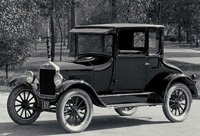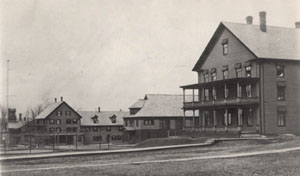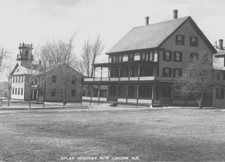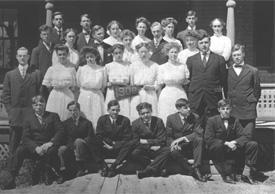If It Were 1907: Looking Back a Century

In 1907, Theodore Roosevelt was president of an America that had 46 states and 87 million people. A U.S. Congressman's salary was $7,500, a year's subscription to Good Housekeeping magazine cost a dollar, and a first-class stamp was two cents.
Finland gave women the vote in 1907, 13 years ahead of America. The U.S. invaded Honduras, the automatic washer and dryer were introduced, and the Hoover vacuum cleaner and the fax machine were invented.
UPS was founded that year, the first radio broadcast of a musical composition was aired, and J.P. Morgan and other financiers banded together to end the 1907 Bank Panic by investing in the New York Stock Exchange.
Quite a few 1907 babies would become household names, including W.H. Auden, Katharine Hepburn, Laurence Olivier, John Wayne, Rachel Carson, Frida Kahlo, Orville Redenbacher and Gene Autry.
Rudyard Kipling won the Nobel Prize for Literature, and the Lusitania's five-day crossing of the Atlantic set a new record.
Meanwhile …
On a hill in rural New Hampshire, amid changing leaves and hints of the winter to come, 132 students began the 1907-08 school year at Colby Academy on Sept. 17. Enrolled in one of four academic courses, they came from every New England state except Vermont, plus one student from New York.

The academy consisted of four buildings on what is now New London's town common, the faculty roster listed nine members, and the campus was reached by a daily stage coach from the train station at Potter Place, eight miles away. Electricity wouldn't come to New London until 1916.
Colby Academy Rules
The use of playing cards and tobacco in any form was strictly forbidden at Colby Academy. The use of alcohol was grounds for expulsion, as was hazing “in any form or degree,” profanity, theft, deliberate falsehood, leaving town without permission, and ungentlemanly or unladylike behavior.
While today's students can choose their own class and sleep schedules, in 1907 the Rising Bell rang at 7 a.m. every day but Sunday for breakfast half an hour later. After 40 minutes of recreation, all students went to chapel exercises at the Baptist church next door, and classes – or recitation periods, as they were called – commenced at 9 a.m. The library of 4,000 volumes was in a large bright room with six windows which “afforded plenty of light and presented a very attractive appearance.”

At 4:15, the male students had 45 minutes of “gymnasium work,” as did the young ladies, starting at 5p.m. Supper at 6 p.m. was followed by a half hour of free time and then an evening study period. All lights were out by 9:45 p.m., though for “sufficient reason permission may be granted by teachers in charge for extension of lights.”
Though students today are more likely to pull an all-nighter than turn in before 10 p.m., there are some similarities between the institutions of 1907 and 2007. For instance, New Hampshire still contributes the most students to the student body - 133 of the 382 incoming students, in 2007, are from the Granite State.
Keeping Abreast of the Time
A hundred years ago, the Colby Academy trustees boasted in the Annual Catalogue that “the school has kept abreast of the time by enlarging its curriculum to meet the demands of an advancing scholarship and a progressive age. It has invested endowment, and in addition a number of scholarships. The former lightens the general expenses of all students, while the latter are a special aid to worthy students who need help.”
Today's trustees can be equally as proud, as Colby-Sawyer College has continued to “keep abreast of its time,” adding programs and facilities. The campus now has 29 buildings on 200 acres and offers 13 degree programs. The faculty has climbed to 126 members, 61 of whom are full-time professors. In September 2007, the college is near its 1,000 student capacity. The incoming class, with its 382 members, dwarfs its 1911 counterpart, which numbered 37 and graduated 15.
Getting In
In 1907, candidates for admission to any one of the four Academic Courses of Study (Classical, Literary, Scientific or Commercial) had to be prepared in Arithmetic, Geography, English Grammar, English Composition, United States History, Spelling and Elementary Physiology.
“All candidates for admission, not personally known to any member of the Faculty, must bring testimonials of good moral character. Students entering from other schools must present certificates for work previously done, and an honorable dismissal from the school last attended.
“When a student is unable to secure or maintain in each study a grade of 60 per cent, his connection with class becomes merely probational, and may be terminated at any time at the discretion of the Faculty.” Once admitted, students were advised to bring with them a raincoat, overshoes, umbrella and a gymnasium suit. Each boarding pupil furnished their own towels, soap, sheets, pillow cases, one pair of blankets, “comfortables,” a bed spread or couch cover, a napkin ring and a laundry bag.
Staying In
In 1907, financial aid was as important as it is today to offset tuition and fees. Back then, having a roommate in your “well located, carefully heated room furnished with chamber sets and carpets” would save you $20, leaving a bill of $172, or about $3,800 in today's dollars. Day students enjoyed a steep discount, paying just $40 total for the fall, winter and spring terms. Not included in tuition, however, were laboratory fees, a library fee, text books, stationery, music, use of a typewriter and the graduation fee.
Children of ministers were given a discount of three dollars per term. Boarding students leaving Friday afternoon and returning Monday morning and having no laundry at the Academy were given a reduction of 20 percent from the regular rates.
Even then, the tradition of work-study was well-established, as the Academy was proud to aid “a very limited number of students that enter under this rate by means of work assigned in connection with the Academy. The compensation for this labor reduces the amount of the cash payment for the year by about $50 ($1,106.48 today). Such students will be required to do any work assigned to them promptly and well. In case of sickness or absence, a substitute must be provided at expense of the student … The object of the plan is to make possible an education for a limited number of young people, who are worthy of assistance and who are willing to help themselves.”
The average scholarship awarded was $40 per student.

The Senior Class
In 1908, Colby Academy graduated 24 students. By 1923, according to an alumni directory, three of them had passed away. The remainder lived everywhere from New London and Boston to Indiana, and were reverends, professors, war veterans, spouses and parents.
The students who entered Colby Academy in 1907 and graduated as the 15 members of the Class of 1911 had lost two classmates by 1923, endured a World War as nurses and soldiers, and spread across the globe as far as Cape Verde off the coast of Africa.
Where will Colby-Sawyer's graduating seniors of 2008 end up? What will the incoming Class of 2011 accomplish in their years on campus, and where will that experience take them?
We won't know that for some time, but many current students might agree with what the Colby Academy trustees said in 1907 about their school: “There is no place in New England, always famous for excellent schools, where health and education are more fully assured than on New London Hill. Students from the cities are greatly benefitted by a residence of a few years in this old country town.”


